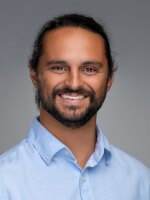It’s only been about a week since San Diego’s Migrant Welcome Center closed, but advocates for asylum seekers and other migrants said they were already overwhelmed.
Records show U.S. Customs and Border Protection (CBP) agents have dropped off more than 1,000 migrants into the streets of San Diego since the center closed on Feb. 22. Advocates say an influx like this in such a short amount of time shows the dire need for funding that as of now isn’t there.
“There is no local, county or federal support,” said Paulina Reyes, a managing attorney with the Immigrant Defenders Law Center.
Immigrant Defenders is one of several nonprofits, mutual aid groups and advocacy organizations serving migrants at the Iris Avenue Transit Station in San Ysidro.
Approximately 350 migrants are dropped off at Iris Avenue every day. From there, advocates and volunteers transport them to the Old Town Trolley Station, where they have access to a free airport shuttle and the Amtrak rail system. More than 95% of migrants dropped off in San Diego move on to other cities in the United States, according to both county officials and volunteers on the ground.
Until late last week, the county’s Migrant Welcome Center, run by the nonprofit SBCS, was servicing everyone processed by CBP in San Diego. The center offered a place to rest while they made travel plans and provided free food and Wi-Fi. Since October, the center served more than 81,000 people, according to SBCS.
The county set aside $6 million to fund a welcome center through the end of March. But SBCS, the nonprofit chosen to manage the day-to-day operations, ran out of money before the end of this month.
The closure happened with no proper notice or a transition plan in place, said Meghan Zavala, a policy analyst with Al Otro Lado.
When immigrant advocates asked for county funding in September, they emphasized the need for long-term solutions like a physical space where migrants would receive services. But that didn’t happen.
“Despite the infusion of $6 million, we have no welcoming infrastructure to show for it,” Zavala said.
Reyes applauded the center’s work. But said it is not a substitute for long-term solutions. “We are frustrated that the money was spent in the way that it was, without creating lasting infrastructure,” she said.
Policy experts said welcoming migrants and asylum seekers into the U.S. doesn’t have to be chaotic.
“The reception of new arrivals doesn’t need to be only through a crisis or emergency response,” said Kimiko Hirota, policy advisor for the Women’s Refugee Commission. “It works so much better when we are able to work collaboratively and not back away from the work but instead lean into it.”
She pointed to Jewish Family Service in San Diego, which is an example of orderly and sustainable welcoming programs.
The nonprofit has welcomed more than 200,000 migrants in the last five-and-a-half years. Long-term success requires a lot of collaboration, said CEO Michael Hopkins.
“This work is bigger than Jewish Family Service or any one organization,” Hopkins said. “It’s bigger than the county, it’s bigger than the city, or the state. All partners need to have skin in the game.”
Jewish Family Service receives funding from the federal government’s Shelter and Services Program, and from individual donors. Even though they have funding through this year, those dollars are not fully guaranteed for next year.
Despite record demand for migrant services, the overall funding picture remains cloudy. Budget deficits in California could lead to cuts at the state level. And guessing what federal funding will look like next year is close to impossible until after the November election.
This has advocates worried.
“We are a border community, we are a border state,” said Kate Clark, senior director of immigration services at Jewish Family Service. “Folks are going to be fleeing for protection from all over the world. Our unsheltered system is broken, our immigration system is broken.”
But as of now, local leaders haven’t come up with a plan.
At their regular meeting Tuesday, supervisors accepted a plan to seek federal funding to establish a “long-term transit site and shelter.”
Having a specific plan, which includes a center large enough to accommodate 500 people a day and is near a transportation hub, can be used to advocate for state and federal funding, according to the staff report.
Supervisors accepted the plan on a 4-1 vote. However, they acknowledged it is entirely dependent on federal funding, of which there are no guarantees.
Pedro Rios, an advocate with the American Friends Service Committee, said the region needs more imaginative leadership.
“As members of a governing body, they should understand their roles and responsibilities and not just simply say, ‘Here’s $6 million — fix it,’” he said.
KPBS reached out to San Diego Mayor Todd Gloria and County Supervisor Nora Vargas. Neither responded to questions.






